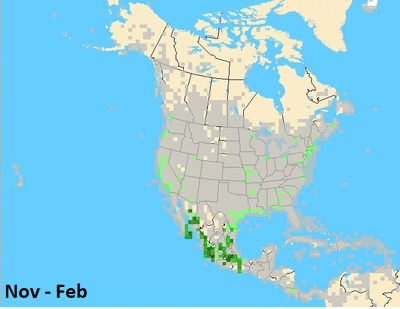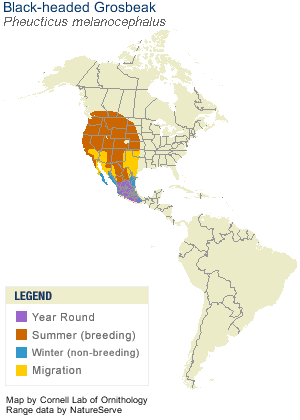After a couple of years of birding and enjoying the Black-headed Grosbeak, I started to wonder about it's name. I thought its massive bill in two shades of metallic gray was pretty cool, not gross. Then a french-speaking friend of mine told me that gros in French means thick. In the dictionary it defines gros as big, large, thick, and fat. Well, that does make sense and it is an appropriate name for this awesome bird of the western United States.
 |  |
The Black-headed Grosbeak winters in Mexico. In April it is entering the American Southwest. By May, its distribution is widespread across the western United States. In June and July the range is still large, but sightings appear to be more isolated and regionalized as the Grosbeaks are nesting and raising their young. In August and September we start to see the southward push and by the end of October they have made their way back to Mexico. For my friends in the eastern half of the United States, your best chance at seeing a mis-guided vagrant Black-headed Grosbeak in your neck of the woods will be late fall or winter. I'll send you some Black-headed if you send me some Rose-breasted Grosbeaks!






...cool-looking birds...another one I haven't seen. I need to pack Matty and Rick up and head out west to see all these western birds! ("Gross" means big or large in German also...)
ReplyDelete@Kelly - thanks for the tip about gross in German. In Spanish it is grueso, so I am guessing that they all came from the same roots. Travel certainly is the easiest way to see new birds and we've got some good ones out west!
ReplyDeleteRobert, I love those grosbeaks! I saw my first ever black-headed one in the Layton area back in the early 2000's. I use to see them in AZ also. It's fun to think some of my sightings contributed to that eBird data from which you made that map! Great shots of that bird and that beak! Love the lazuli!
ReplyDeleteThough the guide book indicates I should see him often, only once have I seen the black headed grosbeak at my feeder. Nice shots.
ReplyDeleteBeautiful details of the bird in your photos. The range diagrams are very interesting. This is one bird I did see when I was visiting over there a few years ago.
ReplyDeleteI am lucky to have these beautiful birds nesting somewhere near by. In early summer they bring their youngins to my feeders. This year we have been seeing a huge influx of Black-headed Grosbeaks and Evening Grosbeaks. Strange weather I think.
ReplyDeleteGreat shots of the male grosbeak and the Lazuli Bunting Robert.
I'll take that trade if you include the bunting too!
ReplyDeleteThanks all for your nice comments! I am now hoping that some Evening Grosbeaks will show up!
ReplyDeleteLovely photos! I got to see a female black-headed grosbeak while I was at Bosque del Apache NWR a few weeks back. A special treat, since we don't have them in Louisiana!
ReplyDelete